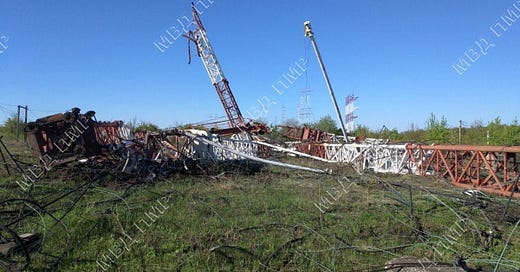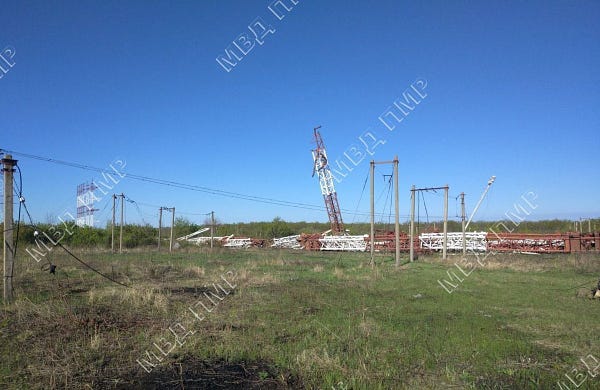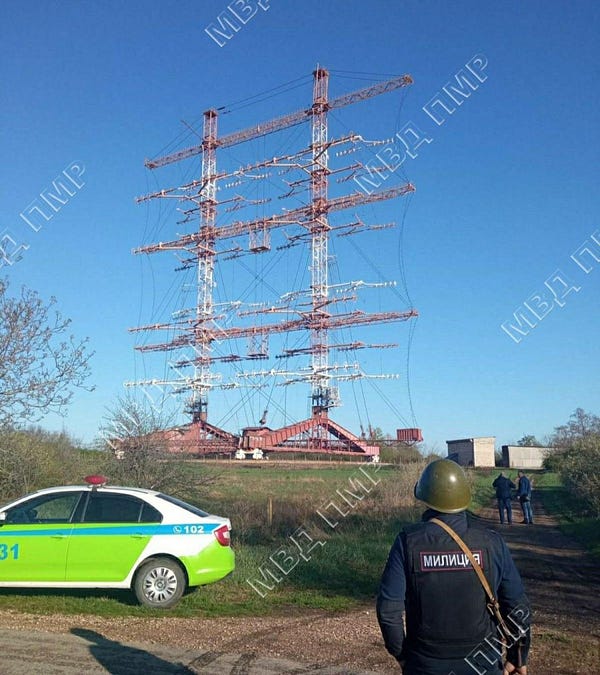Welcome back to Moldova Matters. This week we’re continuing our new format called “Quick Hits” where we will write important updates on evolving stories during the week. For now, we’ll use this format to keep more regular updates moving on the Russia - Ukraine crisis and specifically how this impacts Moldova.
What We Know
In the last day multiple attacks have been carried out by unknown actors in Transnistria. No one has claimed responsibility for these actions and factual information is scarce. Here’s what we know:
April 25, 17:00 the Transnistrian Ministry of State Security (KGB) was hit by multiple attacks by what are most likely RPGs. The building was damaged with windows blown out and multiple apartments close by were also damaged. No one was injured or killed.
April 25: 23:30 - 2 explosions were recorded at an airfield on the Transnistrian Ministry of Defense territory (basically a small military airstrip in the region). The attack was supposedly carried out by aircraft or drone. No one was injured or killed.
April 26th morning. A large AM radio transmitter was destroyed in Transnistria. No one was injured or killed.
At the same time, missile and rocket strikes have continued in Odessa. Importantly, the Zatoka bridge was hit today and is damaged and impassible. Ukrainian authorities will not release more information citing security concerns. This bridge has no understandable military use to Russia at this time but critically cuts off of all of Ukraine south of Moldova from Odessa. Currently, this region can only connect to the rest of Ukraine through Planca - a road traveling through Moldova.
US Defense Secretary Lloyde Austin, speaking from Poland summed the situation up well. He noted that the US is monitoring the situation in Transnistria but is “not really sure of what’s that all about.”
That’s the common theme in Moldova. Let’s try and pick it apart as best we can.
Moldovan Response
Following the news of the attacks in Transnistria breaking, Moldovan authorities began a series of emergency consultations and meetings. SIS (Security and Information Service - Moldova’s intelligence agency) called an emergency meeting and assured the public that they are monitoring the situation and called for calm.
President Sandu convened a meeting of the Supreme Security Council. After which she announced the following measures:
increase the intensity of movement checks near the Security Zone;
increase the intensity of patrols at the border and within the country;
increase the level of protection of critical infrastructure facilities;
increase the level of readiness of institutions responsible for public order and security.
The President had the following statements (selected quotes) following the meeting:
“Our analysis revealed tension within the region, between different forces, some of which are interested in destabilizing the situation. We condemn attempts to jeopardize the security of Moldova and insist on a peaceful resolution of the Transnistrian conflict through diplomacy,”
“We do not control this territory, but it is ours, and Moldovan citizens live there, whose safety is our priority,”
“According to the currently available information, the forces of the Transnistrian region are involved in attempts to escalate the situation in the Transnistrian region. These are forces advocating war, they are interested in destabilizing the situation,”
Transnistrian Response
In Transnistria, the authorities there have declared a “code red” terrorism threat. They have increased the vigilance of “border” checkpoints, sent all students to online learning through the end of the year, and canceled the May 9 Victory Day parade. Official statement is as follows:
“The main issue is terrorist attacks on infrastructure facilities and state institutions of the republic. Three facts were recorded: the building of the Ministry of State Security in Tiraspol, the military unit near the village of Parkany and the towers of the radio and television center near the village of Mayak were damaged,”
The leader of the region, Vadim Krasnoselsky, said the following in an address to residents of the region:
“As the first conclusions of the urgent operational and investigative measures showed, the traces of these attacks lead to Ukraine. After the outbreak of hostilities in Ukraine, Transnistria maintained neutrality and openly declared this - that we are not aggressors, that Transnistria did not plan and does not plan to attack our neighbors. (...) I assume that those who organized this attack have the goal of dragging Transnistria into the conflict,”
Following President Sandu’s statement attributing the attack to factions within Transnistria he responded with the following:
“Unlike Ms. Sandu, we absolutely know where the terrorists came from and in the direction of which state they left. I assure you, they have nothing to do with the Transnistrian people,”
Meanwhile, Kremlin Spokesman Dmitri Peskov said that the situation is a "cause for concern" but that they had no plans to talk to President Sandu.
Ukrainian Response
Since the attacks became public, Ukraine has largely attributed them to Russian “provocations.” “Provocations” in Russian means something like a “false flag” attack suggesting that the Russian security services attacked their own proxy forces.
An advisor to Ukrainian President Zelensky posted the following:

Regardless of the attribution of attack, the “Chisinau gates” comment strikes as extremely accurate.
Ukrainian intelligence had the following statement:
“Obviously, this case [explosions in Tiraspol] is one of a number of provocative events organized by the FSB to whip up panic and anti-Ukrainian sentiment. As conceived by the authors, they must justify the war on the territory of Ukraine or involve the "PMR" [Transnistria"] in the fighting. Or as a territory with a certain mobilization reserve, or as a territory from which Russian troops can carry out attacks on Ukrainian territory, ”
They further published a letter from a local mayor in Transnistria asking central authorities where he could find a bunker / civil defense agency in his town. Ukrainian sources say that since this letter was sent 3 days ago it indicates prior knowledge of the attack.
Ukraine’s General Military HQ announced this evening that Russian forces in Transnistria are now on full alert.
Additionally, Russian propaganda channels have begun pushing out information in Transnistria that Ukrainian forces will soon attack them with rockets or cruise missiles. Ukrainian intelligence says that this is fake news and propaganda but notes that they think Russia will conduct a strike against civilian targets in Transnistria as a false flag attack.
What the hell is happening?
If that’s what you’re thinking, you’re not alone. At this point we need to move into the realm of analysis and even speculation. Nothing is clear at this point. Here’s what we know:
Moldova blames rogue factions in Transnistria trying to stoke war.
Ukraine blames Russia. A position supported but a wide range of regional experts both in and out of Moldova.
Transnistria blames Ukraine.
Russia struck a bridge in southern Ukraine that has no military value for them at this time.
Let’s try and unpack these ideas with the question cui bono? in mind (who benefits)
Scenario 1: Russia Attacks it’s own Proxies
The scenario where Russia organized these attacks through its intelligence agencies is widely believed in and out of Moldova. In this case we would assume that the Kremlin is organizing a pretext for intervention in Moldova by showing that Transnistria is under threat. This gives them a pretext for war in Moldova and supports their (many many) claims on state TV and from their military that Russian speakers in Moldova are under threat.
The problems with this scenario are legion. Russian troops remain held up near Kherson in Ukraine and are loosing ground daily not moving towards Mykolaiv much less Odessa. They are also not pre-positioning troops for a southern push at this time and are concentrating all their forces in the Donbas. This means that Russia has no credible plan to link up with Transnistria in the short, medium or maybe even long term. Threats against Moldova are essentially just rhetoric unless this situation changes wildly. At the same time, Ukraine has substantial forces in the area and Russian troops in Transnistria have no heavy weapons. Should this front of the war open up, Ukraine is more likely to drive to Tiraspol than a handful of poorly trained and provisioned Russians are to drive to Odessa (or Chisinau).
At the same time, rumors are rampant. It’s worth noting that well sourced (but unconfirmed) rumors are circulating that up to 4 Russian planes with paratroopers left Crimea today for points unknown. Meanwhile, the destruction of the Zatoka bridge cuts off southwestern Ukraine from easy military supply. Could all this mean something for Moldova? Almost certainly not. An attack in this direction from sea or air is incredibly hard to imagine. That said, Russia has not been known for solid battlefield logic so far in this fight.
Scenario 2: Ukraine is Behind the Attacks
It can’t be ruled out that Ukraine is behind the attacks in Transnistria. The radio tower that was destroyed was the largest AM radio transmitter in Europe and was used to broadcast Russian propaganda into Ukraine. In theory, this makes it a “dual use” facility and a legitimate military target by Ukraine. At the same time, using a drone to drop a few bombs on a remote airstrip and sending a few guys to fire RPGs into the KGB building is not logical militarily. From a messaging standpoint, you could make the argument that Ukraine benefits here. They send the clear signal to Europe that this is not just a war for Ukraine but for the whole region and that it could spread.
Maybe? This is also hard to understand. Ukraine is gearing up for a major fight in the east and its allies and partners in the west are sending massive amounts of heavy weaponry right now. Why have a risky operation in a 3rd country why you are already getting what you want? Critically, sources in Ukraine as well as public messaging from the Ukrainian authorities seem more confused than anything else. They are (correctly) warning that Moldova is involved whether it wants or not and the war is on the doorstep. But no real attempt has been made to capitalize on the situation.
Scenario 3: Transnistrians did this
The Moldovan government scenario suggests that rival factions within Transnistria are fighting and at least one group is pushing the country towards war. This is plausible and describes an economic and geopolitical fracturing of the elite. In this situation, there are “pro-war” elements that want to push Transnistria into taking a more active role in the fighting most likely supported by Russian agents. At the same time, this scenario isn’t really that different from the “Russia did it” scenario. Any groups acquiring weapons and attacking institutions that were empty (conveniently or because of Easter holidays) would likely have Russian support.
So what do we know?
Not much. Something has certainly started in Transnistria but what it is and what the goal might be is unclear. One friend noted the “Murder on the Orient Express scenario” whereby the Russians attacked the KGB headquarters for all the reasons mentioned above. Seeing this, the Ukrainians then attacked the radio transmitter because they would have plausible deniability. Speculation like this just highlights how many unknowns there are.
A massive unknown is why the bridge at Zatoka was attacked. By itself this could look like a strange accident in the fog of war. But taken with the Transnistria attacks it looks significant. With this bridge out of commission southwestern Ukraine is effectively cut off from the rest of the country. There is still a road through Palanca which is Moldovan territory rented by Ukraine. But the idea they can move military equipment through Moldova (rent or no) is hard to imagine. This region in the south is incredibly sparsely populated with very little infrastructure. Could Russia be intentionally isolating this space? Could they be crazy enough to try and open another front in southern Ukraine from the sea? What’s going on?
As Secretary Austin said… we’re “not really sure of what’s that all about.”








The bridge at Zakota is of strategic relevance as there is the only railway line between Odessa and Izmail. The currently only operational ports in Ukraine are the ports of Izmail and Reni both located at the maritime section of the Danube river, and only Izmail is connected via railway to Odessa. Thus the supply chains for some cargo to and from Odessa was re-organized via Izmail and now this important supply chain is interrupted.
Off the cuff, can't help thinking that with Tiraspol 100 km from Odesa, Odesa's reputation as an "interesting" port, and who knows what kinds of portable weapons hanging around in sheds and old armories, those targets would be awfully tempting and convenient to Ukrainians who are otherwise pretty far away from the action. (Or even Moldovans, who were exchanging fire with Transnistria not so long ago.)